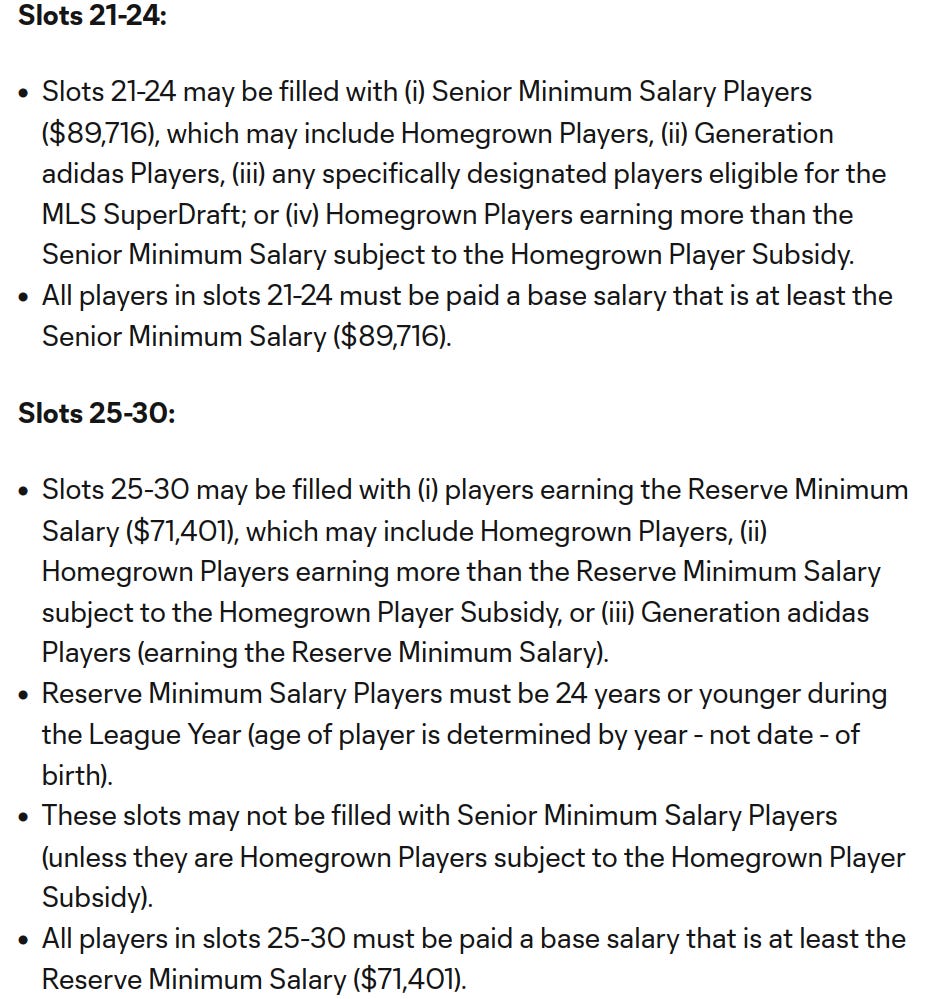MLS Salaries And The Law
As I mentioned yesterday, Major League Soccer exists as a centralized company that controls all aspects of top level professional soccer in the United States.
Among other things, Major League Soccer has an incredibly robust and predictable salary structure. This structure is extremely detailed, is largely predictable, and depends on certain numbered positions within the roster.
For example, the roster rules and regulations describes roster spots 1-20 this way:
Afterwards, slots 21-30 are described this way:
Salary information for all players is also made public on this MLSPA site.
This is unique among the major U.S. sports. Salaries are frequent topics of discussion in the American sports media, of course — but no other league has salary rules that even approach these in terms of robustness, or in terms of how strict the salary cap is.
Fitting into that salary cap is one of the fun (and frustrating) parts of a Major League Soccer save in Football Manager, by the way. It’s like trying to write a poem within a certain rhyming scheme, or trying to create music given certain very strict composing guidelines. Sometimes excessive structure will result in something extremely creative and satisfying.
But how can they get away with this? This kind of structure is antithetical to fair competition, right?
Well, it turns out that a group of 8 players sued Major League Soccer under the Sherman and Clayton Acts back in 1996. The league won the initial trial in 2000. The players then appealed, and the appellate court ruled in favor of the league in 2002.
Now, I should warn you that I’m not a lawyer. All I can do here is provide information from the ruling itself, and allow you to draw your own conclusions.
Major League Soccer’s strict centralized control was discussed early in the ruling:
Or, as I said yesterday, the players are employees of Major League Soccer, not of their respective teams.
Now, the question here was whether Major League Soccer had a monopoly over the salaries of soccer players in the United States.
That’s a pretty difficult question if you think about it for a while. While Major League Soccer certainly has a monopoly over the domestic game, it could be argued that it has to compete with foreign leagues for player salaries.
In fact, we know that MLS has been frustrated by its own rules and robustness as it has tried to compete with foreign leagues for top players. On the one hand, the powers in charge of MLS have tried to prevent the league from repeating the errors of the NASL, which spent money it did not have on the best players it could find. On the other hand, the MLS has had to make numerous exceptions to its salary cap rule to allow teams to make lucrative offers to players who otherwise would not play in the United States. And we’ll get into those salary cap exceptions in future posts.
After making what strikes me as a technical case that the league is somehow not an example of overwhelming central control, the appellate judge goes on to say:
This seems to me to be an argument that Major League Soccer might not exist at all if it were not for its robust and monopolistic salary structure. And then the judge rules that the structure itself is not monopolistic at all:
In other words — the fact that players could conceivably find employment at soccer organizations abroad means that the robust MLS system is not a monopoly.
It’s an interesting argument, and, honestly, one that I think actually has quite a bit of merit. It’s one of those situations where you know what you’re getting if you decide to go to the MLS with your playing services.
Personally, though, I wish the MLS would adopt a structure similar to what we see in most European leagues. As things currently stand, there is little real incentive for teams to actually compete — a problem that all major American sports leagues face. The league also faces extreme problems in attracting good talent and retaining it.
What do you think?








